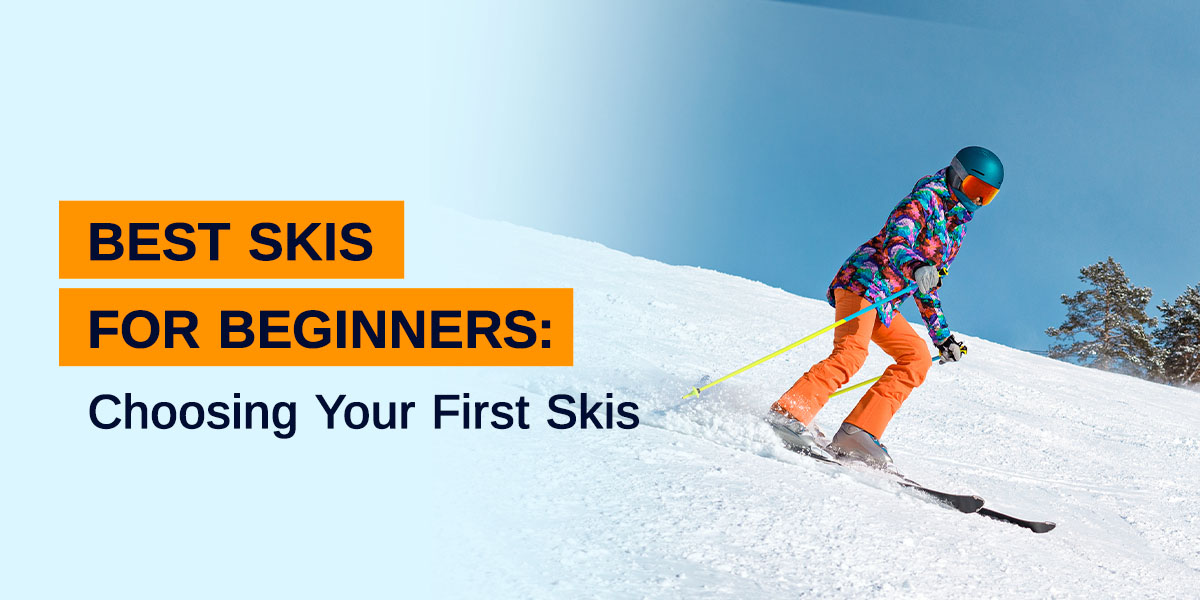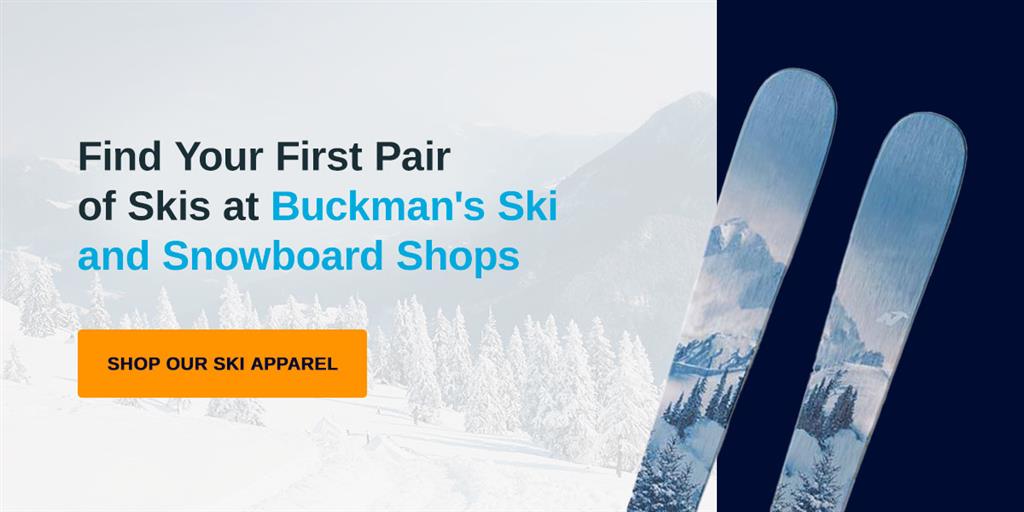 Best skis for beginners
Best skis for beginners
Best Skis for Beginners
Posted
by
Matt Gahman
on Tuesday, January 23, 2024
The adrenaline rush you get from skiing down the mountain is unlike anything else, and the right skis only enhance the experience. Whether you've worn your fair share of rentals or want to jump right into the world of skiing with a brand-new pair, here's everything you need to know about how to choose your first skis.
Understanding Ski Sizes and Types
When buying your first skis, you should consider your height, weight and ski ability, as these impact what ski is best for you. With this in mind, a good place to begin when buying skis for the first time is to understand ski sizes and types. Here's a quick breakdown of what ski length, width and flex mean for you as a beginner.
1. Ski Length

When choosing your ski length, it all comes down to personal preference, but the general rule regarding ski length is to find skis that come up somewhere between your chin and the top of your head.
For beginners, a shorter ski that comes up to about your chin or mouth is an excellent choice. Shorter skis are easier to control, easier to turn and well-suited for lower speeds.
A longer ski may be difficult for a beginner to maneuver but makes an excellent option for intermediate and advanced skiers who like to go fast and plan on encountering varied terrain.
As you research skis, you may notice that ski lengths are measured in centimeters. A good rule of thumb for beginner skiers is to find a ski that is about 10 centimeters shorter than your height.
Additionally, if your weight is below average, you'll want a shorter ski, while you'll want a slightly longer ski if your weight is above the average for your height.
2. Ski Width
When purchasing your skis, you'll notice ski dimensions are measured in millimeters (mm) and sometimes displayed in three numbers, such as 119-88-107 mm. Let's break down what these numbers mean:
- The first number indicates the widest part of the tip, or front portion, of the ski.
- The second number is the ski's width underfoot, which is the narrowest part of the ski found near the center of the ski.
- The third number is the widest part of the tail — the back portion of the ski.
For the most part, when purchasing a ski for the first time, the width underfoot is most important. As you progress and fine-tune your skiing technique, the tip and tail width become more essential. They're vital when it comes to the ski's sidecut, which determines the size of the ski's turn and the ski's stability on various terrains.
If you are unsure of the width of a ski, check the name. Many skis indicate the width underfoot at the end of the ski's name. For example, the "Nordica Santa Ana 88" has an 88-millimeter width underfoot.
For a beginner, skis with narrow widths underfoot are a great option since they tend to be easier to maneuver. Look for skis with a width between 70 and 85 millimeters.
Skiers who like to make tighter and quicker turns also enjoy skis with a narrower width underfoot since they make it quicker to move from one ski edge to the other.
As you progress as a skier, you might opt for wide skis, which allow for more float and are ideal for carving your own path. Skis with a mid-level waist width offer both agility and floatation and can help you transition from narrow to wide skis if you're looking to take things off-trail.
3. Ski Flexibility and Profile
The level of flexibility determines how much force is required to bend the ski. Soft skis are easier to bend and, thus, easier to turn. Soft skis are also more forgiving, which is beneficial when you're learning to ski. Look for a ski with a soft to medium flex that's made with either a composite or wood core — or a mix of both.
Stiff skis allow advanced users to apply more force, but they are less forgiving of technical mistakes. Stiffer skis tend to be made of a mix of denser wood cores and can have metal added to their construction to make them more rigid.
Ski profile is also an important consideration, and to understand the options, you'll have to understand the terms "camber" and "rocker":
- Camber: When laying skis flat on the floor or putting two skis together, you'll notice the skis aren't entirely flat. There's some space near the center of the ski where the ski lifts off the ground or away from the other ski. This curve is referred to as camber. As you ski and make turns, you apply weight and flex onto the skis, flattening the camber. This, along with the ski's sidecut (hourglass shape), helps you turn and provides better grip and edge hold on harder-packed snow.
- Rocker: Rocker is the opposite of camber. Rocker is the arc or curve in the ski where the skis touch the ground when lying flat on the floor. Rocker is found at the front (tip) or back (tail) of the ski, or at both ends. Rocker in the tip of the ski is helpful for initiating turns and helps the ski be more forgiving and less likely to "catch an edge" on hard snow. Rocker is also crucial in powder, as it lifts the tip and tail upward, allowing the skis to float in the lighter snow.
A ski with a combination of camber and rocker in the tip and tail makes a great choice for beginners to easily make turns while still being forgiving and easy to maneuver.
Common Mistakes to Avoid When Buying Your First Skis
When buying your first skis, you can learn a lot from the mistakes of other people. Here are some mistakes to avoid making when ski shopping.
1. Buying What Everyone Else Has
Peer pressure is more common than you might think, even when it comes to shopping. As a beginner skier, you might need help figuring out where to start, and following the other skiers in your life could seem like the easiest option. However, with this strategy, you might choose skis that make skiing more difficult than necessary.
Instead, research skis based on your height, weight, skill level and preferences. Better yet, chat with a professional, as they can guide you on the right ski brands for beginners.
2. Purchasing Equipment From the Wrong Supplier
To save costs, you might buy your equipment from somewhat unreputable sources like Facebook. While this could save some money upfront, it could end up costing you in the end. For example, skis might have hidden damage or be older than advertised.
When you buy skis from a reliable ski shop, you can verify the product's quality with an expert and ensure you're getting an option that suits your specific needs and will last for a long time.
3. Buying Other Gear That Hinders Performance
The skiing experience is largely dependent on the gear you use. Investing in quality skis is essential, but high-quality skis can only enhance the experience so much if the rest of your gear hinders your performance. Finding proper-fitting boots, the correct size poles and bindings that match your ability is essential when out on the slopes.

Find Your First Pair of Skis at Buckman's Ski and Snowboard Shops
Part of the fun when learning to ski is choosing your first pair of skis. As a first-time buyer, you'll want to focus on the ski length, width, flexibility and profile to ensure you have an adventurous experience that's suitable for your skill level.
Buckman's provides high-quality skis for people of various skill levels. You can shop our skis online, using filter options to find your first pair. If you still have questions, reach out to our experts! They can help you pick the best first skis to buy that allow you to have more fun without sacrificing safety.
Categories:
Ski equipment
|
Ski & Snowboarding Tips
Tagged: ski, ski and snowboard equipment